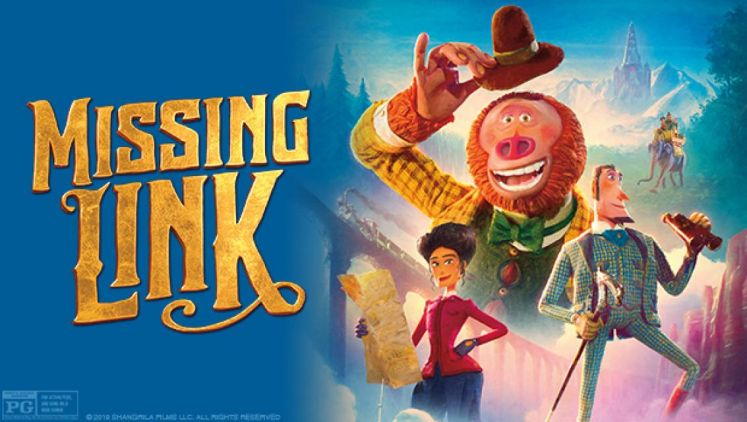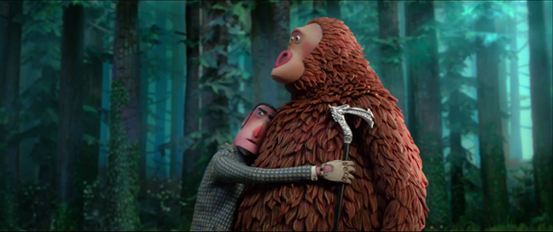Going into Missing Link fans of studio Laika’s other films may think they know what to expect. A top-notch, more sophisticated, stop-motion animated film. And yet, while Missing Link is a Laika film tried and true, it nevertheless bends the mold if it doesn’t quite break it. For those who don’t know, Laika is the studio behind Coraline and Kubo and the Two-Strings, darker and more mature animated films to be sure. But it’s worth mentioning that Missing Link is a much more lighthearted film than these two, and in the pantheon of Laika films (they also made Paranorman and The Boxtrolls), it fits squarely in the middle as a film that can appeal to kids and adults alike.
Missing Link begins with a great intro involving Sir Lionel Frost (voiced by Hugh Jackman), a British explorer, looking for proof of the Loch Ness Monster with his assistant. It’s easy to overlook at how great a job this sequence does in setting up everything to come. The monster hunt is daring yet hysterical, as Sir Lionel dryly remarks “oh, a carnivore” when Nessie goes to eat his companion. It also showcases the central conflicts and themes of the film, as our protagonist desperately wants to get proof that the folklore does exists, but fails to show empathy for his fellow man, or, uh, monster.
After this, the central plot of the film kicks off once Sir Lionel Frost once again faces rejection from the fancy Optimates Club in London that he so dearly wants to join. At his wits end, he receives a letter from someone seeming to have found Bigfoot in the Pacific Northwest and sets out to prove the stuffy club members wrong so that he can join. When he arrives in the Pacific Northwest, he finds that the letter came from none other than Bigfoot himself (Zach Galifianakis). The cryptid informs Sir Lionel that as the last of his kind, he’d like to journey to the Himalayas to find a home with the Yetis there, distant cousins. Since a giant, hair, 8 foot tall monster is fairly conspicuous, he’d like help. Sir Lionel agrees, seeing this as his chance to prove his worth to the club. Since the Yetis live in Shangri La, they need a map held by a former friend of Sir Lionel’s, Adelina Fortnight (Zoe Saldana). Together they adventure across the world as the head of the club, Sir Piggot-Dunceby (Stephen Fry), aims to put a stop to their quest.
As an early 20th century globe-trotting adventure film, I was pleasantly surprised at how it reinvigorated the genre. Don’t get me wrong, Raiders of the Lost Ark is one of my favorite films, but subsequent films in the genre tend to fall in the shadow of it and the other adventuring greats. Missing Link has a great postmodern take on the genre. While many of the films dealing with that era seem to glorify colonialism, this one shows the movement’s detrimental effects in a way that feels natural. All of the club members obsess over conquering something and displaying trophies. I half expected Sir Lionel to engage in the played-out cliche of getting terrified of the Sasquatch, who he names Mr. Link, and needing to get calmed down, but he takes it all in stride. Displaying Mr. Link as a trophy never crosses his mind, as he sees monsters as something to marvel at rather than destroy.
That being said, the central character arc of Sir Lionel does in fact involve learning to overcome selfishness. While he’s happy to help Mr. Link get to Shangri La, he’s only in it to get the proof he needs to get admitted to the club. Many films, especially animated ones, deal with the theme of learning to care for others, and Missing Link treads all-to-familiar ground in this regard. There’s never an especially compelling reason for why Sir Lionel only cares about his wants, as the club he wants to join seems old-fashioned and dull, and he’s already regarded in some circles as a seasoned adventurer. However, the film’s themes shine in another aspect, that of what it means to be a family and have a home. All of the characters want a place to fit in, and the film shows how home often isn’t a place, rather a state of mind, and how family can take on different meanings. It’s a great lesson for kids and adults, as everyone deals with finding a sense of belonging at several stages in life, whether it’s in starting school or moving to a new town.
Early in the review I mentioned how people who have seen other Laika films will recognize the stop-motion animation style, which involves designers making models of the characters and sets and moving them frame by frame. However, the animation is ironically so well done (and aided by CGI) that you specifically knew that it was the case, you’d likely never realize it wasn’t a CGI animated film the whole way through. As someone who’s seen their other films, I wasn’t even sure they had used stop-motion, and only found out through a mid-credits scene which showcases the process. This obviously doesn’t detract from the film, it’s beautiful regardless, but I wondered why the animators seemed to go to such lengths to hide the unique film-making process.
Written and directed by Chris Butler, Missing Link boasts a great cast. One gets the sense that they had a lot of fun making the film. I can’t say for certain whether any of the lines were improvised, but it certainly seemed like there were a few, especially from Galifianakis. Either way, the film has a lot of quick one-liners and muttered quips, which may warrant repeat reviewing. Even if some of the dialogue treads through common tropes, the humor and heart definitely shine through.
Summary
Missing Link proves to be a fun, humorous film that breathes fresh air into the action-adventure genre. The members of the talented voice cast sound like they’re having a blast, and the world of the film is beautiful to behold. The latest Laika film serves as a great animated comedy that’s equally enjoyable for kids and adults.





